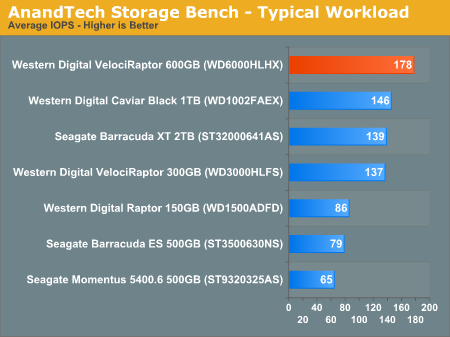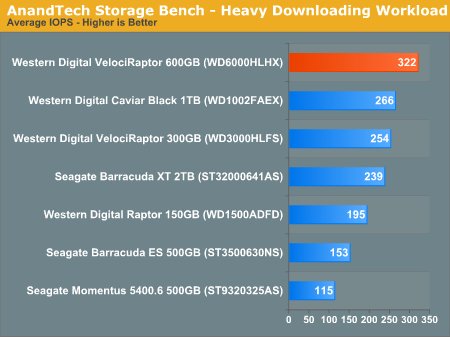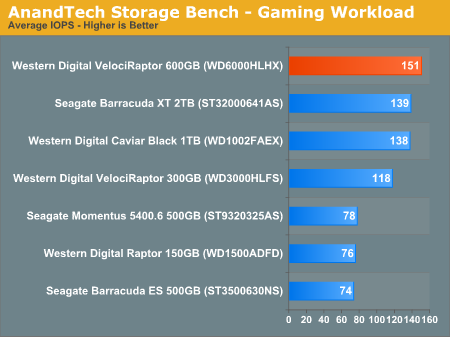Western Digital's New VelociRaptor VR200M: 10K RPM at 450GB and 600GB
by Anand Lal Shimpi on April 6, 2010 8:00 AM EST- Posted in
- Storage
AnandTech Storage Bench
The first in our benchmark suite is a light usage case. The Windows 7 system is loaded with Firefox, Office 2007 and Adobe Reader among other applications. With Firefox we browse web pages like Facebook, AnandTech, Digg and other sites. Outlook is also running and we use it to check emails, create and send a message with a PDF attachment. Adobe Reader is used to view some PDFs. Excel 2007 is used to create a spreadsheet, graphs and save the document. The same goes for Word 2007. We open and step through a presentation in PowerPoint 2007 received as an email attachment before saving it to the desktop. Finally we watch a bit of a Firefly episode in Windows Media Player 11.
There’s some level of multitasking going on here but it’s not unreasonable by any means. Generally the application tasks proceed linearly, with the exception of things like web browsing which may happen in between one of the other tasks.
The recording is played back on all of our drives here today. Remember that we’re isolating disk performance, all we’re doing is playing back every single disk access that happened in that ~5 minute period of usage. The light workload is composed of 37,501 reads and 20,268 writes. Over 30% of the IOs are 4KB, 11% are 16KB, 22% are 32KB and approximately 13% are 64KB in size. Less than 30% of the operations are absolutely sequential in nature. Average queue depth is 6.09 IOs.
The performance results are reported in average I/O Operations per Second (IOPS):

Performance in our real world benchmark however makes it very clear that no other hard drive is as fast as the 600GB VelociRaptor. WD delivers a nearly 30% improvement over the old drive, and 22% better performance than the new Caviar Black series.
If there’s a light usage case there’s bound to be a heavy one. In this test we have Microsoft Security Essentials running in the background with real time virus scanning enabled. We also perform a quick scan in the middle of the test. Firefox, Outlook, Excel, Word and Powerpoint are all used the same as they were in the light test. We add Photoshop CS4 to the mix, opening a bunch of 12MP images, editing them, then saving them as highly compressed JPGs for web publishing. Windows 7’s picture viewer is used to view a bunch of pictures on the hard drive. We use 7-zip to create and extract .7z archives. Downloading is also prominently featured in our heavy test; we download large files from the Internet during portions of the benchmark, as well as use uTorrent to grab a couple of torrents. Some of the applications in use are installed during the benchmark, Windows updates are also installed. Towards the end of the test we launch World of Warcraft, play for a few minutes, then delete the folder. This test also takes into account all of the disk accesses that happen while the OS is booting.
The benchmark is 22 minutes long and it consists of 128,895 read operations and 72,411 write operations. Roughly 44% of all IOs were sequential. Approximately 30% of all accesses were 4KB in size, 12% were 16KB in size, 14% were 32KB and 20% were 64KB. Average queue depth was 3.59.

Upping the number of writes doesn't change anything, the new VR is 26% faster than the old one and 21% faster than the best 7200 RPM drives. Keep in mind this is pure I/O performance, the real world performance is most likely in the 3 - 10% range on average which is what we saw in PCMark Vantage and SYSMark 2007.
The gaming workload is made up of 75,206 read operations and only 4,592 write operations. Only 20% of the accesses are 4KB in size, nearly 40% are 64KB and 20% are 32KB. A whopping 69% of the IOs are sequential, meaning this is predominantly a sequential read benchmark. The average queue depth is 7.76 IOs.

Sequential read performance is solid on the new VR, but not that much better than other, larger (and cheaper) drives on the market. Western Digital's advantage over the old VR is a healthy 27%, but over newer 7200 RPM drives it's barely 9%.










77 Comments
View All Comments
Per Hansson - Saturday, April 10, 2010 - link
I agree and would also like to see how a drive like the Cheetah 15k.7 would perform vs this VelociRaptorDen - Monday, April 12, 2010 - link
I have the (old) 150 GB raptor. What happened to make the 2.5" ones (300 and 600 both) so much noisier than the old 150? 8.5 - 9 dB(A) louder is about three times as loud!bakedalaskan - Friday, April 16, 2010 - link
Though not a price/performance issue along the lines of this article, I notice the position of the SATA connectors appear to be relocated through some kind of adapter compared to the original design 300GB VelociRaptor/ICEPAK combination. My complaint with the original 300GB drive/ICEPAK is that they don't fit in the drive tray system that I like to use on all my PC's. It appears that the new design would address standard SATA drive tray and hot swap backplane standards.dude117 - Tuesday, August 17, 2010 - link
would this make sense as a datastore for a ESX4.1 home lab to run around 20 VMs , mostly Win2003/2008, off?I would prefer a SSD drive but i am not sure how fast the drive will be dead if the VMs are constantly utilized.
Romulous - Monday, August 30, 2010 - link
I have configured several vsphere 4 servers running 8 * 300G raptors in raid 10 on a 3ware (now LSI) 9650SE controller. This configuration is very fast. (8 drives in raid 5 takes a fair performance hit though). A single drive would only work if only one operation happened at a time. This configuration would not make a serious server. It all depends on the work load you anticipate. The production servers we run for one type of VM service have 48GB ram and dual quad xeons, plus the 8 raptors in raid 10. They run over 30 VMs. File system space is the real limiting factor without a SAN.GTXRaptor - Tuesday, November 16, 2010 - link
What would really be a mind = blown moment would be a VelociRaptor SSD.Fastest SSD on the planet :).
One can dream.
crackedcoms - Thursday, January 12, 2012 - link
Learn about the latest Xrumer news today its cool and has stuff and ewrwe yeahhh